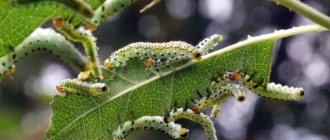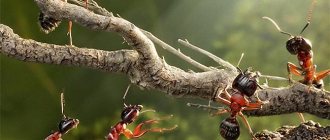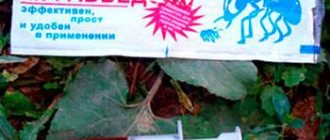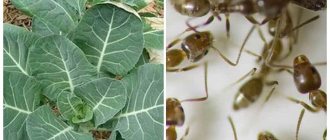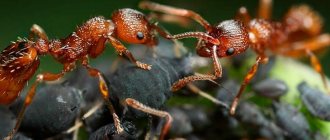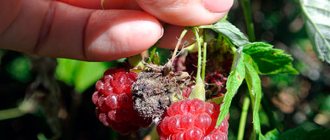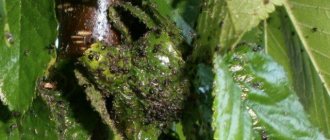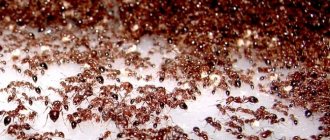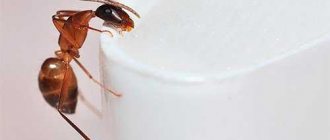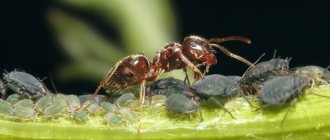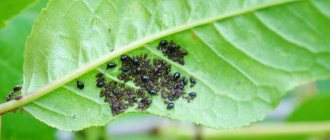Ants do not cause serious harm to peonies; they feed on the sweet nectar that forms on the buds. Flowers most often bloom normally, at the usual time. However, insects cannot be called completely harmless; they bring aphids to flowers in large quantities, and aphids damage the tissue of young leaves, destroy the smallest buds and are carriers of dangerous diseases.
To be closer to the food source, ants can settle near peony bushes; if their nest is located directly in the root zone, the plants will die over time due to malnutrition or the development of rot. Why do ants appear on peonies, how to get rid of them, how to treat buds and flowers: chemicals, traps and folk remedies.
Why do ants appear on peonies?
The ants' diet largely consists of carbohydrates, which they obtain by feeding on honeydew and the sweet nectar of certain plants. Insects are attracted to the sharp, sweet aroma of peony, emanating even from unopened flowers. Ants that settle on buds feed on the juice that has already been released; very rarely they gnaw through the bud in search of nectar.
On a note! Buds damaged by ants dry out or bloom, but the flowers become deformed and discolored.
If insects have already settled on peony bushes, they will bring aphids to them, which, in the process of vital activity, secrete honeydew - a food source for ants. Aphids reproduce very quickly, they destroy young leaves, buds and even peony flowers. Due to impaired photosynthesis, plants lose immunity to infections and cold resistance decreases.
About the tastes of insects
Many amateur gardeners wonder why there are ants on peonies. There are several reasons why ants love peonies. This plant seduces:
- Nectar. Ants hunt for nectar, which contains a lot of nutrients for insects.
- Protection. Quite often, ants make a nest under a peony bush, which perfectly camouflages their home.
- Food for aphids. Ants spread aphids, for which the petals and buds of peonies are considered one of their favorite delicacies.
Ants on peonies
How to get rid of ants before peonies bloom
To ensure that insects cause as little harm as possible, stems with small, newly formed buds (the size of a pea) are treated with various repellents. They use special gels - Agrus, Cleanbeit, Liquidator or folk remedies. This method has a significant disadvantage: during the budding period it often rains, water will wash away the substances, if you do not coat the stems again, the ants will reach the target again.
A good alternative is wood ash; as soon as the stems begin to grow, the powder is scattered in a circle near the trunk; it will not only repel ants, but will also nourish the plants. At the same time, make sure that there is no excess of potassium, phosphorus and calcium; in this case, the product cannot be used, otherwise the development of plants will be disrupted. Before and at the beginning of flowering, baits, traps and barriers are placed around the bushes.
Using poisonous baits
If a small number of ants are observed on peonies, a special poisonous bait will help. It's very easy to prepare. It is enough to take a little boric acid (5 g), a small amount of sugar or honey and mix thoroughly.
The resulting mixture is laid out in close proximity to the peonies affected by ants. Having sensed the sweet bait, most insects will leave the flowers, and having tried the “delicacy” they will die. Some gardeners recommend adding regular yeast to boric acid instead of sugar or using cornmeal mixed with sugar as bait. The effect will be the same.
How to treat peony buds against ants
All means are good in the fight against ants, but you need to consider what plants, shrubs or trees are located in the neighborhood. Flowers are not treated with chemicals if there are apiaries nearby, berries, fruits, vegetables (with fruits already set) and herbs grow. The packages contain detailed information about the time period between use of the products and harvest.
Chemicals are not used if there is no goal to completely get rid of ants; in addition to harm, they bring benefits, they eat the larvae and caterpillars of some pests. Folk remedies are used throughout the summer; they are harmless to other plants, beneficial insects and the environment. Safe substances give a weak and short-term effect; treatments are repeated every 5–10 days.
Use of folk remedies
Folk remedies have one undeniable advantage: the solutions and mixtures used are always free of any chemicals or aggressive substances that can harm the structure of plants. You can get rid of ants that decide to feast on flowers by diluting a special solution that needs to be sprayed on peonies. To prepare and use it you should:
- Pick a few fragrant leaves of lavender, mint, parsley or wormwood, and then pour boiling water over them in a container.
- After the product has infused (it needs at least an hour for this), it should be poured into a spray bottle or spray bottle.
- Spray the solution over the entire stem and leaves of each peony.
- Use the remaining product to water the soil around the flowers.
Such a product is, firstly, completely harmless to peonies, and secondly, it can permanently drive away insects from the area on which it was sprayed. It is recommended to repeat the procedure to consolidate the effect two to three times a week.
Advice: ants are absolutely unable to tolerate the smell of garlic, so you can either place several cloves of garlic near the plants, or rub their juice on the stems.
All methods of fighting ants on peonies
It is useless to shake insects off peonies; a more effective method is to wash them off. Take settled water, heated by the sun, add a little laundry soap or dishwashing detergent (20 g per 5 liters of water), with a soft cloth, and carefully wash the buds. The procedure is permissible only in the morning and evening hours; if you rinse the flowers during the day, burns may remain on the sepals. The method gives a good result if there are few ants, but if there are a large number of individuals, they carry out a complex fight.
Store-bought drugs
When choosing chemicals, take into account that aerosols give a temporary effect; dead ants will quickly be replaced by new ones. Gels and most powder products (for preparing solutions) act on the digestive system of insects, substances are transferred from one individual to another, most often this leads to infection of the entire colony.
What drugs give good results:
- Ant-eater. A powder or liquid product containing diazinon, a potent poison that attacks the intestines of ants. In stores you can often find ampoules, 1 is enough for 10 liters of water.
- Expel. A German drug based on chlorpyrifos, it is also produced in the form of powder and emulsion. Use the product strictly according to the instructions, which may vary (depending on the form of release of the substance).
- Muratsid or Ant. They act in the same way as the first drug.
Attention! Solutions of any product cannot be stored; they are used immediately after preparation; they are used to treat bushes, soil around tree trunks, and anthills.
The downside of chemicals is that they are harmful to bees and other beneficial insects, as well as animals and birds. Failure to follow the instructions for use can lead to serious poisoning and other dangerous consequences (rash, irritation of the mucous membranes and skin). Plants are treated in the morning or evening in dry, windless weather; gloves, a mask and closed clothing are worn. Other commonly used drugs are Inta-vir, Grom, Vallar, Kapkan and Karbofos.
Traps
When placing baits with toxic substances, make sure that beneficial insects cannot get into them. For example, they take small plastic bottles or jars with rubber lids and make small holes so that only small individuals can fit through them freely.
Various preparations for traps can be bought in the store; the following have proven themselves to be good:
- Blattanex Ant Bait. Contains food additives, sugar. The ants eat the bait, carry it to their nests, spreading it throughout the entire anthill. The first individuals die within a few days; complete destruction takes from 2 to 8 weeks (in large numbers). The granules are scattered dry into prepared containers or in places where there are large concentrations of ants.
- Ameisen Aeroxon. It attracts insects and affects their nervous system, the ants carry it to the queen and brood, and within a short time the entire colony dies. With this remedy you can get rid of the problem within a day.
- Combat and Raptor. Special preparations consisting of several ready-made traps.
Purchased products are replaced with a composition of 5 g of boric acid, 50 g of honey and 50 g of water, the mixture is mixed until a homogeneous mass is obtained, transferred to a trap or scattered around the bushes. Having smelled the “treat”, the insects will leave the buds, and having tasted it, they will die. Instead of honey, you can use sugar or jam, the effect will be the same. In order not to destroy the ants, but simply to distract them from the peonies, prepare the usual sweet bait. Several small containers are filled with syrup, placed around the flower bed, and the liquid is added or changed daily.
Barriers
Barriers (ribbons, tying with cloth impregnated with insecticides, whitewashing, etc.) are more convenient to use on young trees or thin branches of shrubs, but there is also an option for peonies. A circle with a diameter of up to 16 cm is cut out of thick cardboard, a small hole is made in the center, the size of the stem, so that there is no gap left. The circle from the outer edge to the inner is cut and put on a twig, closer to the bud or flower. The bottom of the cardboard is generously greased with Vaseline.
Barriers like tires with water dug around bushes practically do not work. The first individuals fall into the trap, the rest break through passages under the barrier and freely reach the buds. This method of control is dangerous; in order not to lose their food source, insects build homes right in the root zone, and this inevitably leads to the death of peonies.
Repellent odors
A good way to prevent the appearance of ants on peonies is to use plants whose aroma they cannot tolerate: wormwood, tansy, marigolds, garlic, lavender, parsley, mint, anise and bay leaves. The latter can be taken dry (seasonings). Infusions are prepared from repellents for spraying; some of them are planted around the perimeter of the flower garden. Rub the stems of peonies with a clove of garlic until they bloom.
Attention! You can scare away ants with tobacco infusion. A glass of cigarette butts is poured into 5 liters of hot water, left for 2-3 days, filtered and sprayed on the plants.
Chop a large head or 100 g of garlic cloves, pour in 3 liters of boiling water, leave for a day in a closed container, filter, process the leaves, buds and stems on all sides. An infusion of any of the plants proposed above is prepared in the same way; a lot of herbs are taken so that the aroma is rich. A little laundry soap is added to the finished, strained infusions, so the liquid remains on the leaves longer.
The usual interval between treatments is 5–12 days; if it rains constantly, the bushes are sprayed more often. In cases where it is not possible to visit the dacha often, you can put a rag soaked in kerosene near the bushes (in the depths of the flower garden). The sharp, pungent smell will scare away ants and other harmful insects, but you won’t be able to enjoy the delicate aroma of flowers. Ants do not like the smell of conifers, but they cannot be used in beds with peonies, the needles acidify the soil, and plants develop well only in a neutral environment.
Folk remedies for ants on peonies
If for some reason it is not possible to treat plants with special chemical insecticides and acaricides, get rid of annoying insects using various means that are in the kitchen or in the medicine cabinet. The results from them are no worse, and some give a quick and long-term effect.
Let's highlight the already proven and most effective options:
- 1 tbsp. l. vinegar essence is diluted in a bucket of water, the bushes are irrigated with the mixture, and the buds are always treated.
- Baking powder is scattered in the root zone and along the perimeter of the flower bed. Take about 50–100 g of powder per 1 m². The ants die from such a treat, but the bait is used only in dry, windless weather.
- The soil around the bushes is loosened, a repellent mixture of soda, quicklime and wood ash is scattered over the surface, the ingredients are taken in equal parts. The same mixture is sprinkled on anthills.
On a note! If there are few ants on the buds, they can be sprayed with a weak soap solution, a teaspoon is enough. shampoo per 1 liter of water.
Small anthills located near peonies are filled with boiling water with the addition of soda ash - a pack per bucket. Instead of soda, use ammonia, 100 ml is enough for the same amount of liquid. A mixture of 250 ml of dishwashing detergent, 1 liter of table vinegar, 500 ml of oil per bucket of water gives good results, pour the liquid into large anthills. A small depression is made at the top, poured gradually, then the nest is covered with polyethylene, left for a day and dug deep.
Ant - friend or foe?
Here are the ants clinging to an elderberry shoot with aphids, fussing about on the buds of peonies, digging holes on the warm, dried surface of the ridges, here they are dragging a caterpillar, a straw, a needle... ant life is in full swing, never stopping for a minute.
I’ll say right away that the ants on the site are our salvation, they are necessary and irreplaceable. They are one of the protectors of our plants from caterpillars, slugs, fly larvae and other pests. In addition, ants help maintain and increase soil fertility and improve soil structure. In places where an ant family lives, the phosphorus content in the soil increases by about 10 times, and the potassium content by about 2 times. Phosphorus and potassium from insoluble forms become soluble, that is, they become available to plants. However, the acidity of the soil in the area of the anthill is much higher, and not all plants can grow and develop normally in high soil acidity.
Here is an interesting way to get rid of spider mites from indoor roses without chemicals, suggested by a visitor to our forum. She claims that it is enough to place a pot of a rose infected with a spider mite near an anthill, and after 3-5 days the ants will clear it of the pest. However, where is the guarantee that the ants will not bring their beloved aphids onto a rose freed from mites?
If we look at the diet of ants, it turns out that they eat mainly carbohydrate and protein foods. Moreover, carbohydrates are for adults, and proteins are mainly for larvae. The German myrmecologist G. Wellenstein, after more than 25 years of studying red forest ants, established that their “menu” consists of:
— honeydew (honeydew) – 62%;
— plant juice – 4.5%;
— seeds – 0.2%;
— insects and invertebrates – 33%;
- mushrooms and carrion - 0.3%.
Ants have a terrible sweet tooth. The basis of their carbohydrate nutrition is honeydew (honeydew) of aphids, scale insects, scale insects, and leafhoppers. In addition, they eat plant juices, nectar, and fruit pulp; for example, they like to feast on strawberries.
You can often see ants clinging to peony buds. What are they doing there? They feast on nectar.
The fact is that nectar is released not only by flowers, but also by peony buds. Ants are not limited to collecting nectar from the surface of buds. They gnaw the sepals and petals so that the nectar is released more intensely. As a result, many buds dry out without opening, and if a gnawed bud does open, the flower will be one-sided and ugly.
The Japanese poet Yosa Buson calls the peony an “ant palace”:
“The Ant Palace—the crimson peony opens the front gate...”
And let the ants run around in the open flowers of peonies, but there should be no ants on their buds.
They love ants and the seeds of some plants. There are plants that, without ants, would not be able to spread their seeds. These are, for example, fragrant violet, hairy violet, European hoofed grass, celandine, and corydalis. The seeds of these plants have peculiar formations, nutritious appendages called elasmosomes, which are eaten by ants, after dragging the seeds into the anthill. Some of the seeds are lost along the way. The method of seed dispersal by ants was called myrmecochory. In general, there are about 3000 species of myrmecochorous plants in the world, that is, about 1% of the planet’s flora.
The protein food of ants consists of insects and other invertebrates, both living and dead.
It is curious that in the spring and early summer the basis of the diet is birch sap and honeydew of aphids, then the ants begin to actively hunt insects, and at the end of summer and autumn they again switch to feeding on honeydew. During the season, one ant family can, in addition to 3-8 million insects, eat 200 liters of honeydew and more than 10 thousand seeds.
However, close proximity to ants also has its disadvantages. If they are actively located in the beds, flower beds, or in the house, you can forget about comfortable work and rest. Anthills are often built in a strawberry bed right in the strawberry bush, which often causes the plants to die. Ants love to settle in the warm, dry ends of ridges, which makes sowing, planting, and processing plants a problem - the ants bite painfully, and they can feast on seeds, as well as spoil seedlings and seedlings. Ants like alpine slides. They are often found under boards, logs, and in stumps, using wood as a building material for an anthill.
What to do to prevent ants from appearing on peonies
Preventing insect attacks on flowers is much easier than fighting them. Prevention consists of regularly inspecting the area and destroying all anthills. The garden is always kept clean, garbage, sawdust, shavings, old boards, weeds, fallen leaves and other plant debris, branches are removed, and stumps from trees and shrubs are uprooted. When transplanting peonies from one place to another, wood ash is added to the holes and into the soil for backfilling. Repellent plants are planted in flower beds with peonies.
Getting rid of anthills on the site is painstaking work, but this is the only way to protect peonies. Ants are especially dangerous for weakened plants, as they are carriers of fungal infections. A constant companion of insects, aphids are capable of destroying young plants in a few days and infecting them with viral diseases. It is better to fight ants comprehensively, using various methods, this will guarantee a good result.
Did you like the post? Add it to your favorites
All your articles will be on this page.
Send the article to your social network!
Prevention of ants
Undeniably, the best method against ants on peonies, as in the case of any other plants in the garden, is timely prevention of the appearance of pests. To achieve the desired result it is important:
- till the soil in a timely and efficient manner;
- plant repellent plants;
- spill the root part and soil around the perimeter of the flower garden with the solutions discussed earlier in the article.
Preventing the appearance of pests on peonies will help keep the flowers beautiful and healthy.
Block
The point of this method is to create a barrier for the ants that they cannot cross. It's very easy to make, it just takes a little time. To prepare this barrier you will need a knife, old tires and water, which almost everyone has. The tire is cut lengthwise and placed around the bush, one might say it is put on with the hole down, all that remains to be done is to add water, this method will help get rid of not only ants, but also other pests.
You can make a trap out of cardboard, for this you make a circle with a diameter of 15 centimeters, after which a hole is made inside the circle that will allow the cardboard to be placed around the stem, just make a straight cut
Having placed the cardboard, coat it with Vaseline, the ants will get stuck in it and will not be able to get to the plant, it is important that there are no cracks, then the trap will not work
We also encounter ants when we cut flowers, and we don’t really want to bring a bouquet into the house with ants, getting rid of them in this case is very simple, just dip the bouquet in cold water for a while, and then shake it off, for a better effect you can add soap or dishwashing liquid.
Radical measures to solve the problem
Ants on peonies: how to get rid of them if nothing helps? The problem can be solved using more radical methods.
Moving the anthill away from the site
To move the insects' home you will need a bucket or wheelbarrow, a shovel and a little time. You need to dig an anthill and pour the soil into a wheelbarrow or bucket. The collected contents should be taken out and dumped away from the house, for example, in a planting area. A lot of salt, ash, lime is poured into the resulting hole and dug thoroughly.
Fill the colony with water or solution
If the nest has not yet had time to grow, then make do with a large amount of boiling water. But when the size of the anthill is large, then solutions based on the following active ingredients are used:
- boric acid;
- soda;
- lime;
- salt;
- washing soap;
- shampoo;
- vinegar;
- sunflower oil;
- ammonia;
- sagebrush;
- essential oils.
A solution may contain several active components. Before pouring it into the insects’ home, a deep hole is made in the anthill and the liquid is poured into it. To create a solution, it is advisable to take hot or warm water. The flooded colony is covered with polyethylene on top.
- home improvement. Insects build their nests under bushes. Peonies have the ability to grow quickly and extensively, becoming an excellent shelter from sunlight, gusts of wind and precipitation;
- nutrition. Ants love peony juice. For them, it is a delicacy that contains many nutrients;
- aphid breeding. Ants carry aphids to the bushes, which develop well on flowers and stems. These small insects suck the juice from the plant and produce a special substance - honeydew, which black ants feed on.
Ants appear on peonies because they love the sap of the plant.
Insects are not always dangerous for flowers. More often they simply feed on nectar without touching the leaves, petals and stems of the plant. It’s worse if ants appear on peony buds, because when they bite through them, they leave no chance for the flower to bloom. But even those who managed to open up have an ugly appearance. Such plants are not suitable for home decoration, sale, and they just don’t look particularly attractive in the garden.
Being close to their food source, ants actively reproduce. An overgrown colony goes beyond the bush and moves to other plants, negatively affecting their development.
